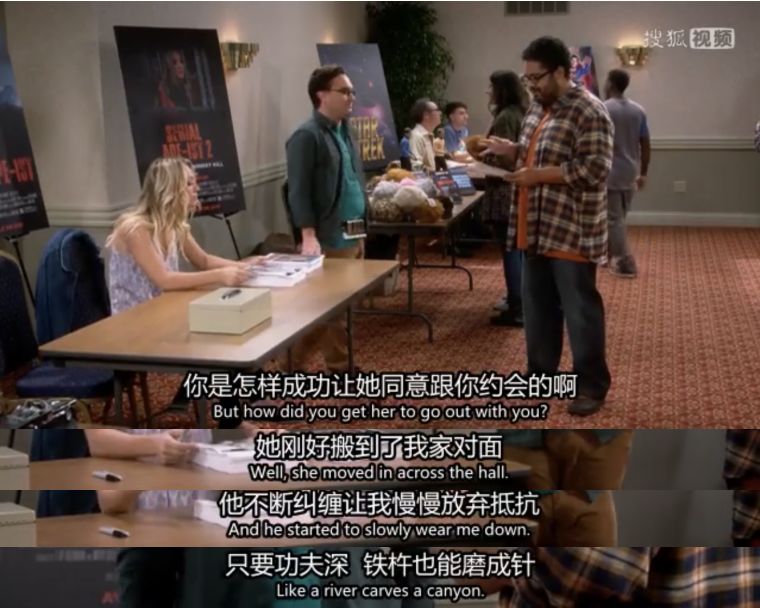
Hello guys, I wanna pose a question here, “When you get tired or have many free time, what will you do to kill time?” I believe that most people will answer: “Watching television plays!” , I am no exception!

With globalization, more and more oversea TV plays were introduced into China, however, the language barriers are our biggest obstacles when watching them. In order to solve this problem, the subtitle translation groups occurred accordingly. Subtitle translations are so common in our daily life, but today we will analyze them in terms of linguistics.
We chose a worldwide popular play The Big Bang Theory(the 10th season) as example to analyze it’s subtitle translation from the perspective of multimodal discourse analysis.

No.1
What is multimodal discourse analysis?
With the development of modern technology and multimedia, especially the emergence of Internet, moltimodality of meanings is in every corner of the world. The single communicative mode has been infrequent, it is common to exchange information with the help of many modalities. And these communications are originally multimodal.
Multimodal discouse sprang up in the 1990s; this analytic method was based on systematic-functional linguistics such as the representatives Kress and van Leeuwen, for attempting that systematic-functional linguistics applies to the research other semiotic resources such as facial expressions, gestures, images and music, etc.
This tweet intends to analyze the subtitle translation of the 10th season of The Big Bang Theory from the culture, context, content and expression levels.
Cultue Level
Cultural level is the key to make multimodal communication possible (Zhang Lude, 2009).
TV plays are a medium of cultural communication. In subtitle translation, the translator's expression and transmission of cultural factors in subtitles will directly affect the audience's understanding of plays. In order to convey as much cultural information as possible, translators may choose domestication as their preferred strategy in subtitle translation. Through free translation, audiences can better understand the ideas and connotations embodied in TV plays.
In the first episode, when Leonard's father quarreled with his mother, his father talked about meeting Sheldon's mother frequently. Leonard's mother thought her husband wanted to anger her in this way, and her husband didn't want to lose the battle, so he said, "And if it antagonizes you, to that's just a bonus. " Subtitle group translated it as “如果这激怒了你,那算是一石二鸟。” Using the Chinese idiom “一石二鸟”to draw the distance close between the play and Chinese audiences.

In the six episode, Leonard had the following conversation with Penny’s fans when when answering their questions about how to marry such a beautiful woman Penny.
In this dialogue, “river carves a canyon” was translated as a Chinese colloquialism “只要功夫深,铁柱也能磨成针”。

Free translation makes subtitle translation not only convey effective information, but also highlight the humorous style of the play.
Context Level
Context includes linguistic context and non-linguistic context. Linguistic context refers to the context on which utterance meaning is expressed in language communication. Non-linguistic context refers to various subjective and objective factors on which utterance meaning is expressed. Linguistic context and non-linguistic context such as picture scenes, linguistic environment, character psychology and facial expression construct the textual meaning of television plays.
In the first episode, because the U.S. military wanted to requisition Howard's research results, the police found his home. His Indian friend Raj mistakenly thought that the police wanted to repatriate him. His Indian friend Raj mistakenly thought that the police came to repatriate him. So when he saw the police, his face was flustered and his eyes were hiding until the police told him that he was coming to find his friends. So Raj said "Very well" and made a bow to the police.
“Very well” was translated as “是的长官”. His expression and Chinese subtitle reflected Raj's inner fear and flattery to the police.

Content Level
As the presentation of subtitles is limited by space and time factors, we should try to keep subtitle translation concise and easy to understand. In subtitle translation, ellipsis is often made in terms of symmetrical addressing, modal particles and pronouns.
In the eighth episode, “You know, I have to say, based on the candy wrappers and the bags of junk food I see in the trash, I thought the person working here was a ten years old.” was translated as“我不得不说,从垃圾桶里的糖果包装纸还有垃圾食品的包装袋来看,我本来以为在这里工作的人是个十来岁的小孩。”The translation of “You know” is omitted in the sentence, because the word does not affect the audience's understanding of the plot.

Expression Level
The medium of meaning transmission mainly includes two forms: voice and writing (Zhang Lude, 2009). The subtitles of TV plays belong to the writing form at the expressive level. In order to make the audience read the subtitles quickly and conveniently, the subtitles are usually set at the bottom of the screen. Generally, Chinese subtitles are presented in one line at a time, while English subtitles are presented in two lines at a time.

After reading my analysis, do you have a totally different understanding of the Chinese subtitles? You can have a try to analyze other TV plays' subtitles by yourself!
点击蓝字关注我们